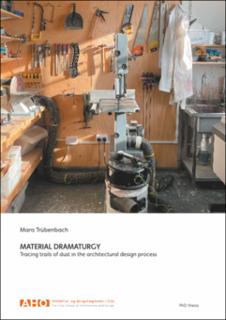MATERIAL DRAMATURGY: TRACING TRAILS OF DUST IN THE ARCHITECTURAL DESIGN PROCESS
Doctoral thesis
Submitted version
Permanent lenke
https://hdl.handle.net/11250/3120720Utgivelsesdato
2024Metadata
Vis full innførselSamlinger
Sammendrag
Following the digital turn of the 1990s, architectural practices moved into a digital world, a development that was further accelerated by the Covid-19 pandemic. In this shift from analogue to digital there is a risk of losing touch with the physical, and skills that are essential for collaborating with physical materials. Widespread digitalisation requires a platform for discussion to recognise the performative potential of materials and to grasp the range of emotions they can induce. The effects generated by materials have implications for human decision-making. Ultimately, materials – as communicators, mediators and performing agents – act with our individual bodies, our memories and our subconscious, participating in a dialogue with them.
To come to a better understanding of the performative potential of materials, this research project deals with what it terms ‘the inner and outer worlds’ of humans and materials, highlighting the lack of a common language to describe their encounters. Focusing on the activities of model-making, textile design and scenography, in this thesis I explore a range of hidden agencies in architectural production that question the relation between human agents and the materials that make up the world around them. I investigate how different understandings of materials operate in the work of human actors, especially individuals who often have a latent agency yet contribute to the process of architectural production. The aim is to understand better the ways in which interrelations and performativity feed back into architectural practice.
To understand such processes, I turn to theatre and performance studies, which provide alternative methods for participation, as well as performance itself. Theatre studies theorise how performance generates a nuanced range of feelings imaginatively and visually, aided by different actors and agents. In this thesis a similar perspective is brought to bear on processes internal to architectural production. As well as the theory of performance, I refer to feminist scholars such as Karen Barad (2003), Rosi Braidotti (2013) and Donna Haraway (2016), whose perspectives on the Anthropocene have been instrumental in shaping awareness of the relationship between humans and non-human beings. These contributions offer fundamental insights to rethinking the ways in which architects might work with, intellectualise and sense materials.
Using the methods of ‘site-writing’ as outlined by architectural theorist Jane Rendell (2010), ethnography and practice-based research, I aim to demonstrate that the actors I study, and the interactions they engage in – between specialist skill and general practice development – generate fruitful but often insufficiently respected sites for the creation of ‘material literacy’ in architectural design. I argue that this potential resides in the ambiguous status of making with materials, which is simultaneously situated within and outside the core concerns of architectural practice. The conclusions in this thesis suggest that individuals who bring sophisticated material literacy into their ways of working play a unique role in learning processes, through which architects can better understand the impact of diverse materials. The empirical work with the model-maker Ellie Sampson and my own model-making practice was carried out at the London- based architectural firm Haworth Tompkins. The studies on the performance were conducted with artist Judith Raum in Berlin, the artistic collective Go Plastic Company in Leipzig, and scenographer and theatre maker Jozef Wouters in Brussels/Vienna.
